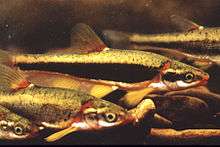Blackside dace
| Blackside dace | |
|---|---|
 | |
| Scientific classification | |
| Kingdom: | Animalia |
| Phylum: | Chordata |
| Class: | Actinopterygii |
| Order: | Cypriniformes |
| Family: | Cyprinidae |
| Genus: | Chrosomus |
| Species: | C. cumberlandensis |
| Binomial name | |
| Chrosomus cumberlandensis (W. C. Starnes & L. B. Starnes, 1978) | |
| Synonyms | |
|
Phoxinus cumberlandensis | |
The blackside dace (Chrosomus cumberlandensis (syn. Phoxinus cumberlandensis)[1]) is a species of ray-finned fish in the family Cyprinidae. It is endemic to the Cumberland River drainage in Kentucky and Tennessee as well as the Powell River drainage in Virginia in the United States. It is a federally listed threatened species.[2]
This fish is 50 to 65 millimeters in length. It is olive green in color with black speckling and a black stripe. During the breeding season in April through July the stripe becomes a deeper black, there are red areas on the upper parts, and the fins become yellow.[3]
This fish is found in 105 streams in Kentucky and Tennessee, but many of these populations are very small, with under 10 individuals. The species has been found in western Virginia, but these populations are believed to have been introduced by people.[3]
The fish lives in cool, clear streams with rocky substrates and overhanging vegetation. It is schooling and lives under banks and rock formations. Other fish in the habitat include the common creek chub (Semotilus atromaculatus), white sucker (Catostomus commersoni), stoneroller (Campostoma anomalum), and stripetail darter (Etheostoma kennicotti). The dace eats algae and sometimes insects. It lives 2–3 years and becomes sexually mature in its first year.[4] The female lays an average of 1540 eggs.[5]
The species is threatened by the loss and degradation of its habitat. The rocky riverbed substrates in which it spawns are degraded by erosion and sedimentation, which are increased by human activities such as runoff pipes from septic tanks, and trash being dumped into streams. Several populations have been extirpated by these processes.[4]
On August 2013, the U.S. Geological Survey released together with the U.S. Fish and Wildlife Service a study which shows that after the spill of fracture-fluid an important number of fish and other water being, including the Blackside Dace, died. It is a result of extremely high stream conductivity of about 35.000 microsiemens and a ph-value of 5,6, which indicate that the water is extreme charged with metals.[6]
References
- ↑ Chrosomus cumberlandensis. FishBase.
- ↑ USFWS. Determination of threatened species status for Blackside Dace. Federal Register June 12, 1987.
- 1 2 Johnson, T. D., et al. Blackside Dace Phoxinus cumberlandensis Species account and Cumberland Habitat Conservation Plan (HCP) survey results. Archived March 31, 2012, at the Wayback Machine.
- 1 2 Eisenhour, D. J. and R. M. Strange. (1998). Threatened fishes of the world: Phoxinus cumberlandensis Starnes & Starnes, 1978 (Cyprinidae). Environmental Biology of Fishes 51(2) 140.
- ↑ Starnes, L. B. and W. C. Starnes. (1981). Biology of the Blackside Dace Phoxinus cumberlandensis. American Midland Naturalist 106(2) 360-71.
- ↑ Papoulias, Diana M.; Velasco, Anthony L. (2013). "Histopathological analysis of fish from Acorn Fork Creek, Kentucky exposed to hydraulic fracturing fluid releases". United States Geological Survey. Retrieved 10 July 2016.
External links
- Gimenez Dixon, M. 1996. Phoxinus cumberlandensis. 2011 IUCN Red List of Threatened Species. Downloaded on 30 August 2011.
